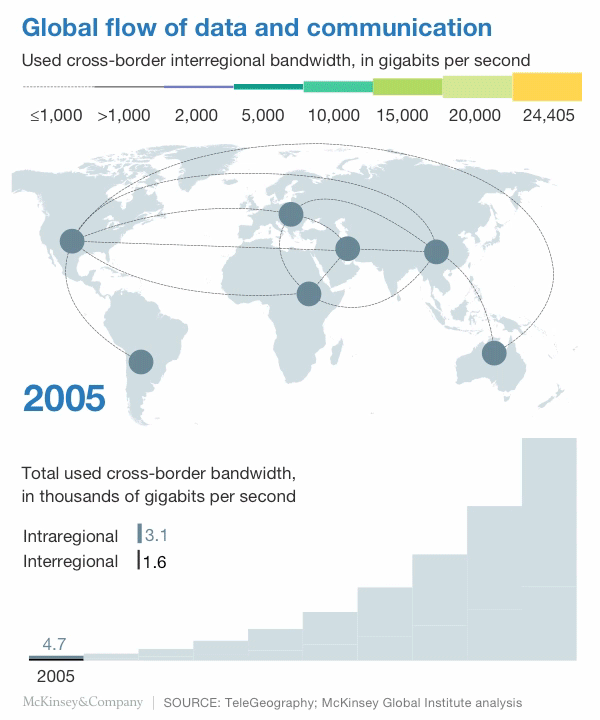Europe is bouncing back after a “lost” decade. Business and citizen optimism has returned and eurozone GDP in 2017 expanded at its fastest pace since the 2008 financial crisis. This changing mood creates an opportunity for European political and business leaders to take the action needed to ensure that growth and well-being are sustained in the long term, and that trust in Europe’s institutions is strengthened.
Rebuilding trust is critical: even in a time of economic recovery, divergent forces linger, anti-globalization sentiment is gaining ground in a number of countries, and distrust of politicians and political institutions is rife. Business leaders, meanwhile, tell us that they favor “more Europe” but still worry about the fragility of the eurozone. Drawing on research by the McKinsey Global Institute, this briefing explores three pathways where Europe could take concrete action to begin restoring trust while sustaining economic momentum:
- Restoring economic dynamism and investment for inclusive growth
- Capturing the benefits of globalization while addressing the backlash against trade and migration
- Embracing automation and AI to drive long-term competitiveness, while addressing challenges from the future of work
- Rebuilding trust through tangible improvements on areas of citizen concern—and more

1. Restoring economic dynamism and investment for inclusive growth
A decade after the global financial crisis, the European economy is gathering momentum, but uncertainty is holding back investment and confidence in economic advancement remains elusive for many.
For much of the past 60 years, the EU followed a similar growth trajectory to the United States, and the gap between the United States and the EU is narrower for various indicators of welfare than it is for GDP. Gender equality in society in the EU is the highest in the world, although it can further improve in the workplace, and the EU as a whole scores strongly across a range of social indicators, from the quality of healthcare and education, to environmental protection, public safety, social protection, and work-life balance. Its trajectory diverged from that of the United States when GDP growth in the EU fell back in a double-dip recession in 2012-13, but the euro crisis that accompanied it has since stabilized and per-capita GDP is back to pre-2008 levels. Unemployment in the EU-28 has fallen below 8 percent, its lowest level since 2008–09.
Stay current on your favorite topics
Recapturing economic momentum will require a renewal of business confidence and investment. Business investment is still below pre-crisis levels, at 12.4 percent of GDP in 2016. Business leaders we surveyed told us that lingering uncertainty and weak demand, which is hampering growth and productivity, is holding back investment. This has real consequences: our analysis shows that if investment of all forms in Europe were to return to pre-crisis levels (as a portion of GDP) by 2020, overall European GDP could receive a boost of €1 trillion in 2030. Underinvestment in critical areas such as transportation, new digital ecosystems, and power grids can erode future growth potential and productivity, which has slowed sharply in Europe post-crisis compared with a decade earlier. In France, Germany, and Sweden, for instance, annual labor-productivity growth has slowed from a 1985–2005 average of some 2 percent to less than 1 percent in 2010–16, while it is close to zero in the United Kingdom. Weak capital deepening is one of the primary drivers.
Large cash holdings are one manifestation of the lingering business uncertainty: EU gross corporate savings exceeded €2 trillion in 2016, almost €500 billion more than in 2009. Of the more than 2,000 C-suite business executives we surveyed across France, Germany, Italy, Poland, Spain, and the United Kingdom, 37 percent told us that their cash position had increased by more than 3 percent. Fueling the reluctance are concerns other than a lack of investment opportunities: just over half of the respondents to a separate McKinsey Quarterly survey said they saw more investment opportunities than they could fund. All this comes at a time when the return on cash is poor because of historic low interest rates. Companies hoarding cash say they are evenly split between “saving for future investments” and “building reserves for potential future crises (Exhibit 1).”

The survey also highlighted a lack of confidence in the future of the eurozone. Most of those we polled told us that the EU has had a positive impact on their business, with 60 percent saying they want “more Europe,” including more centralized authority and spending. However, one in three expected the eurozone to break up or shrink, and 16 percent even expected the EU itself to disband (Exhibit 2).

Among European citizens, concern about rising income inequality and lack of advancement is fueling the lack of trust. Disposable income for the bottom decile has grown more slowly than income for the middle and upper deciles across much of continental Europe over the past decade. However, European societies continue to be more equal than the United States, as measured by Gini coefficients and other metrics. Recession and slow recovery following the 2008 financial crisis alongside longer-term demographic and labor market changes combined to halt advancement of market incomes—both wages and capital—between 2005 and 2014 for as many as two-thirds of households in advanced economies. Taxes and transfers prevented this income stagnation from feeding through to disposal income in some but not all countries: in Italy, disposable income fell for households across the income distribution between 2005 and 2014. All this has contributed to a feeling among many Europeans of “losing out,” at a time when some middle-income jobs are under pressure and low-paying temporary employment contracts are on the rise in many European countries.
Several concrete measures could be taken to address these issues of lingering fragility:
- Structural reform along 11 growth drivers—focused around investing for the future, boosting productivity, and mobilizing the workforce—which could raise Europe’s GDP by 2 to 3 percent annually. About 75 percent of these measures could be enacted by national governments, with the remaining 25 percent at a pan-European level as identified in MGI’s 2015 Window of opportunity for Europe report.
- Rekindling both public and private investment, especially in Europe’s South, which may require concerted action across sectors. One policy choice could be to change public accounting systems to account for public investment as assets depreciate, rather than during capital formation. Such a shift could be combined with a more flexible approach to fiscal deficit targets, as suggested by one submission in our 2016 essay prize contest, to give governments greater flexibility to borrow funds in order to invest in growth-enhancing opportunities.
- Addressing Europe’s lingering debt issues. This will require Europe to strengthen the banking union, clean up weak bank balance sheets, address lingering issues of non-performing loans, and deal with excess sovereign debt.
- Providing a clear pathway for the future of the eurozone. European businesses require both regulatory certainty and a credible plan for the future of the eurozone, to enable future investment. Proposals by French President Emmanuel Macron and European Commission President Jean-Claude Juncker have put the issue high on the European political agenda.

2. Capturing the benefits of globalization, while addressing the backlash against trade and migration
Europe has been at the heart of many of the interconnections that have been forged over the past three decades, amid a sharp increase in flows of goods, finance, people, and data. Today, however, the continent faces a popular backlash against trade and migration—two of globalization’s core tenets. Those disenchanted by globalization are among the most suspicious of European and national institutions, polls show. For policy makers and business leaders, the complex challenge ahead is how to capture the benefits of continued growth in these flows while mitigating negative consequences.
Overall, global trade in goods and services has surged since the 1980s, growing at double the pace of global GDP between 1986 and 2008, as global value chains in manufacturing have woven countries and companies closer together. Our research shows that, together, global flows of goods, services, finance, people, and data have raised world GDP by at least 10 percent, adding almost $8 trillion of GDP. The financial crisis in 2008 reduced imports of goods and led to a sharp pullback in financial flows, especially in Europe: among eurozone banks total foreign loans and other claims have fallen by $7.3 trillion, or 45 percent, since 2007 (Exhibit 3). As in the United States, the banking crisis in Europe in 2008 involving government rescues contributed to the anti-globalization sentiment.

Even as growth in traditional trade and financial flows slowed or dried up after the global financial crisis, a new frontier opened in the form of digital flows—where Europe needs to remove barriers. Use of cross-border bandwidth globally has grown 45 times since 2005. Virtually every type of cross-border transaction now has a digital component, and about 12 percent of the global goods trade is conducted via international e-commerce, with much of it driven by platforms such as Alibaba or Amazon (Exhibit 4). Europe as a whole is well placed to capture the benefits of these flows because its national economies are highly interconnected; in MGI’s Connectedness Index, six European countries rank in the top ten globally. But many barriers still impede the free flow of cross-border data within the European economy; only 15 percent of EU consumers buy online from another EU country, whereas nearly 44 percent do so domestically, according to the European Commission. The commission has also identified numerous national restrictions to the location of data storage or processing.

Concern that “unfair” competition in trade of both goods and services may be killing jobs has helped foment protectionist policies, not just in Europe but globally; since 2009, G20 countries introduced roughly 1,600 trade protectionist measures, according to the World Trade Organization. Unfair trade, along with migration, was a key argument in favor of the pro-Brexit vote in the United Kingdom.
Businesses are concerned about this backlash against globalization. Our survey of European C-suite executives highlighted their optimism about business prospects from digitization and the rise of emerging economies, with those seeing these trends as positive for their business outweighing those who saw them as a negative by a margin of 4-to-1 and 3-to-1 respectively. However, the rise in populism, pressures against globalization, and geopolitical disruption are viewed negatively as main factors running counter to increased investment.
European citizens have been especially vocal about their concerns around migration, and they worry about its implications for safety, security, social cohesion, and jobs and wages. Asked about the main challenges facing the EU, most Europeans mentioned immigration (39 percent) and terrorism (38 percent) in a recent Eurobarometer survey.
Close to three million people applied for asylum in Europe between 2015 and October 2017, and they are distributed extremely unequally. Germany alone has taken in more than 40 percent of these migrants. Integration has been a particular challenge. The unemployment rate among refugees in Germany, for example, was over 50 percent in 2016, at a time when Germany has a shortage of some types of workers.
Would you like to learn more about the McKinsey Global Institute?
Addressing such issues will be essential to heading them off. Options could include:
- Accelerating growth and working to make it inclusive. Driving overall growth can ensure that everyone is better off, and reduce backlash against globalization, but on its own may not be enough. Welfare, regulatory, and training programs will need to be adapted to ensure that nobody is left behind. One of the winners in our essay contest suggested a variety of ways to compensate losers, for example by distributing GDP-indexed shares to workers affected by foreign competition from trade deals.
- Managing the flow of migrants and asylum seekers. As a baseline to rebuilding public confidence, Europe needs to be able to demonstrate to its citizens that it has control over who is entering its borders, and that flows will be managed fairly. Our collaboration with the World Economic Forum brought forth many ideas to manage the flow of migrants and asylum seekers, including expanding digital identity programs, building financial transfer mechanisms to support border countries, and improving repatriation mechanisms.
- Improving long-term integration outcomes. European governments could optimize integration pathways for asylum seekers, providing different elements of integration support in a sequence that reflects different groups’ needs. This could accelerate sociocultural and labor force integration.

3. Embracing automation and AI to drive long-term competitiveness, while addressing challenges from the future of work
Automation technologies, including artificial intelligence (AI), will increasingly disrupt businesses and the workplace over the next 10–15 years. They will bring benefits in the form of increased productivity and corporate performance for companies able to harness these tools, but also considerable transition challenges, as humans work ever more closely with machines, and in some cases, are replaced by them.
In the European public debate over automation, the fear that “robots could take our jobs” is a recurring theme that adds to the climate of mistrust and fear. Our research suggests that historically there has been enough work to offset the portion of existing jobs displaced by technology. The same could be true with future digitization and automation, if the process runs smoothly. However, more than 40 percent of Europeans report that they are either over or under-skilled for their jobs, according to the OECD. Such a mismatch may already affect productivity and job growth, and is likely to increase: millions of people will need to change occupational categories in order to find work in the new economy, and millions more—in European countries including Germany, up to one-third of the workforce by 2030—will need to acquire higher cognitive and creative skills. This represents a massive training and retraining challenge for policy makers and business alike.
Our research has found that the activities most susceptible to automation account for roughly half of the activities that people do and that they exist across the entire spectrum of sectors. For Europe’s five largest economies—France, Germany, Italy, Spain, and the United Kingdom—we estimate that about $1.9 trillion in wages and 62 million workers are associated with technically automatable activities.
The actual impact on work will largely depend on the rate of adoption of automation technologies and the rate at which economies grow and create demand for new work. To illustrate, we estimate that 24 percent of full-time equivalent hours in Germany could be automated by 2030, assuming that adoption falls in the middle of our expected range, although the displacement could be as much as 47 percent if automation is very rapid. Wages are the primary means of building a disposable income for the middle class, and Europe must therefore ensure that the benefits of automation outweigh the risk of job and income loss they may present—including by supporting worker transitions—in order to maintain citizen trust in the new economy.
Seeking to slow (or halt) automation adoption is not a good option. European economies need the productivity boost that automation can bring, especially those whose working-age population declines in countries across Europe. In Germany, for example, ageing will represent a drag of 0.6 percentage points per year on per capita GDP growth to 2030, but early adoption of automation could more than offset that, with an annual boost of 2.4 percentage points. Companies across sectors from agriculture and healthcare to media and pharmaceuticals have already started to use the new digital and AI-powered tools to identify fraudulent transactions, personalize financial products, diagnose diseases, and optimize purchasing, scheduling, and pricing. Doing so has let them capture immense productivity and performance benefits, and the benefits are expected to increase over time.
Europe is falling behind the United States and Asia in capturing the potential value at stake. Unlike the United States and China, Europe has been largely unable to consistently translate its innovation into global digital platforms. Investment in AI is already dominated by digital companies such as Amazon, Baidu, and Google, with Europe lacking the scale of such companies to make notable inroads. European companies including ABB, Bosch, BMW, and Siemens are investing in AI, even if they are not digital natives, but overall Europe is behind in external AI investment. European external AI investment totaled just $1.1 billion to $1.7 billion in 2016, compared with $1.5 billion to $2.5 billion in Asia and $5 billion to $8 billion in North America, based on venture capital and private equity investment in AI companies, and M&A by corporations (Exhibit 5).

This is a challenge for Europe’s economies, as AI seems to be an even more disruptive force than early digital technologies were for companies and countries. In our research, we find that early AI adopters experience positive momentum and profit growth, and can concentrate market share at the expense of slower adopters. Incumbent companies are at risk of losing out to new starters, unless they digitally reinvent themselves with new business models and portfolios of activities. For now, only a fraction of European incumbent companies has taken this road of digital reinvention.
European economies, particularly the ones with low economic growth, will have no choice but to grow and innovate in order for their industries to remain relevant and to create new work activities and occupations. Policy makers will need to address critical challenges from the transitions that will accompany automation adoption, while ensuring that progress happens at pace. The risk is that automation will exacerbate the growth of income inequality and the lack of income advancement. To capture the benefits of automation while avoiding its downside, policy makers and business leaders in Europe have a range of options. They include:
- Embracing AI and automation quickly for the productivity benefits that they bring when worker transitions are successful. If technology absorption is limited, global competition will further dampen the chance of prosperity. We recently estimated that small, open northern European economies could see an additional 1.2 percentage points of additional GDP growth to 2030, with the same or better levels of employment, with automation diffusion.
- Completing the European digital single market and investing in critical digital assets, technologies, and ecosystems. Free movement of data could become a new pillar of European integration. Europe needs to develop an environment that enables the digital economy to grow, which means encouraging innovative research, ensuring access to growth capital, addressing privacy and security concerns, and building demand for key new technologies.
- Transforming education and training. This will require coordination between parents, educators, governments, employers, and employees, with a focus on enabling lifelong-learning, especially for individuals with skills that can be easily automated. One idea proposed by the World Economic Forum initiative is for a “universal learning right” that would give adult citizens tokens, paid for by businesses, that can be redeemed for skills training. Sweden already has “job-security councils,” run by the private sector, which provide displaced workers with a comprehensive suite of income support, training, and coaching.
- Improving labor market dynamics and enabling more diverse forms of work. Greater mobility and better matching of talent with opportunity is needed across Europe to increase fluidity; our research shows that rapid re-employment will be critical to ensure unemployment does not rise in a time of automation. Digital platforms can improve job-matching and create myriad opportunities for individuals to earn income outside of traditional employment contracts. Labor institutions should evolve to reflect more independent work, for example, by ensuring portable benefits.
- Rethinking transition and income support. The European welfare state dating back to the days of Bismarck will need to adapt to become more resilient. If automation does result in a significant reduction in employment and/or greater pressure on wages in some strata of the population, some ideas such as conditional transfers, adapted social safety nets, different forms of taxation, or even universal basic income may need to be considered and tested, as Finland and the Netherlands are currently doing.

4. Rebuilding trust through tangible improvements on areas of citizen concern—and more
Trust is easy to lose and hard to regain. Addressing the issues we have sketched out in this note with concrete steps could help restore a sense that Europe’s leaders are taking action on key areas of citizen concern. But more is needed at a time when many Europeans are asking fundamental questions about the continent’s democratic legitimacy and relevance. Citizens and businesses alike are concerned about Europe’s ability to deliver on its commitments. For example, while the business leaders we surveyed in 2017 were largely positive about the EU Commission’s policy priorities, just 28 percent thought EU institutions were very effective at making and managing policy.
Addressing Europe’s credibility gap is beyond the scope of this briefing note, and would require real evolution of EU and national governance, likely along with new funding and citizen engagement to foster a true sense of belonging. As Europe works to enhance the fundamentals of its democratic legitimacy, policy makers could address elements of citizen and business concerns about governance in several tangible ways. They include:
- Delivering government services—from trash collection to tax collection—more efficiently and cost-effectively: Digitization of government services can play an important role here, as the example of Sweden’s tax agency shows. It embarked on a wide-scale digitization effort in 2006, with new e-filing processes for income statements and VAT returns. Within six years, citizens’ trust in the agency increased to 83 percent from 68 percent. Denmark has taken a long-term, data-driven approach to healthcare system reform, helping raise average healthy life expectancy from 69.6 years in 2008 to 71.4 years in 2015, without increasing spending per person.
- Being transparent about decision-making, particularly at the European level, and strengthening citizen engagement: Europe will need to find ways to enhance the democratic process and become more responsive to citizen concerns. New digital tools can help: for example, open data platforms can create new mechanisms for government accountability. Estonia has offered Internet voting since 2005, and now 30 percent of citizens take advantage of the option. Some European countries are experimenting with publishing elected officials’ expense reports; other countries publish detailed records of public spending.
- Developing a new vision and narrative for European integration: while trust and confidence cannot be regained without tangible improvement to the issues citizens care about, Europeans are more likely to rally around a revamped European Union if they are able to identify themselves with its rationale. A recurring theme of our 2016 essay prize was the need for a clearer and more compelling narrative, one updated for the 21st century, when the savage wars of the 20th century that drove the EU’s creation in 1957 have faded into history. This will need to be more than a shallow PR campaign. To grow, strengthen, become more resilient—and remain a key actor on the global stage—Europe will need to address legitimate concerns and reenchant its people.
The authors also collaborated on the World Economic Forum’s Renew Europe report (PDF–4.7MB).


